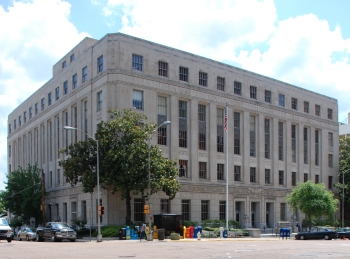
U.S. Courthouse & Post Office, Jackson (1932-34, Hull & Malvaney, archts.)
I don’t know if any of you saw this article in Sunday’s Clarion-Ledger (“When Art Offends,” June 7, 2009) about the awkwardness of the Depression-era mural in Jackson’s Eastland federal courthouse–what to do about the stereotypical and degrading depictions of the black characters in the painting. The mural shows an idealized landscape, with white men in obvious positions of power and responsibility, a few white women looking at their men, and off to the left black men and women bringing in the cotton and one man playing a banjo. At some point, in the 1960s, the judges decided this wasn’t really the best mural to have in their courtroom, so they hung black curtains in front of it.
As the Clarion-Ledger says, “It’s inconvenient art. And how to present works of art that have historical value but are sometimes painfully out of step with modern sensibilities can be an issue for communities.” I actually thought the article did a good job of looking at the issue from a broad perspective, not just this one mural but many different kinds of significant art. For our purposes, as preservationists, many of the issues raised in the article could also deal just as well with different kinds of historic buildings–for instance, what about slave quarters? slave markets? Farish Street (or any other formerly segregrated area of our towns and cities)? Should we preserve the legacy of segregation that those neighborhoods represent?
One thing that sticks in my craw about the federal courthouse mural is that it wasn’t painted by a Mississippian or even a native of this country. The artist was a Russian immigrant living in New York City, and the feds picked him over Walter Anderson, the famously individualistic Ocean Springs artist who was favored by architect Emmett J. Hull (husband of artist Marie Hull) and the rest of the local committee in charge of choosing the artist. It would be interesting to see if we would be dealing with this “inconvenient art” today if the local committee had had its way. Here’s a link to the sketch that Anderson presented to the committee. I admit it’s not my taste, but I don’t see anything overtly racist or stereotypical like I do in the current mural. Who knows whether the local guy would have been able to present a more nuanced and sympathetic mural than the guy from Russia who I’m sure was a good artist but who had no knowledge of Mississippi?
Categories: African American History, Architectural Research, Cool Old Places, Courthouses, Historic Preservation, Jackson, Post Offices

Great comment on an interesting article, EL. I’ve been curious about what’s going to happen to the old courthouse when they open the new monstrosity; that line about moving the mural to the new building scares me.
LikeLike
Yes, I almost mentioned it, but then decided not to. GSA has been pretty good about insisting that the murals stay with the buildings, but then again federal judges seem to be little dictators when they decide they want something.
LikeLike
“The new monstrosity” is a good description. I saw the building for the first time since the St Paddy’s Day Parade and was shocked by the mass of this new building.
As for the Walter Anderson proposal, it’s ironic that choosing Anderson’s vision probably would have been very controversial in that era–it’s not exactly what most people of the 1930’s would have considered a beautiful mural. It just goes to show that often what is “in” now will be “out” later and vice-versa.
LikeLike
That’s a great historical perspective on the mural–I hadn’t thought about how really strange his proposal (and his art in general, of course) must have looked to his own contemporaries. Which makes it even more interesting that it was the local committee that wanted to go with him and the federal overlords who nixed the idea for a “safer” choice. I suspect it was Marie Hull, whose husband Emmett was one of the architects, who was Anderson’s champion.
LikeLike
http://ipseblogit.blogspot.com/2009/12/dear-hardy-collaboration-architecture.html
LikeLike
Lol, very concise but on point!
This made me remember that I took a few pictures of the building a couple of months ago, especially to show its relation to the post office and how unfriendly and unneighborly it is. The pictures start at http://www.flickr.com/photos/26519181@N06/4154234523
LikeLike
Eye-stinging! One of the comments says it looks like two window units!
Hmm, I wonder why they did orient it that way. They’re both federal buildings which is, I’ve thought, why the courthouse was being built there in front of the post office, but, I guess now, it really doesn’t have anything to do with it. Well, if I was the post office I wouldn’t care if that ugly thing snubbed me and that’s not just sour grapes!
LikeLike